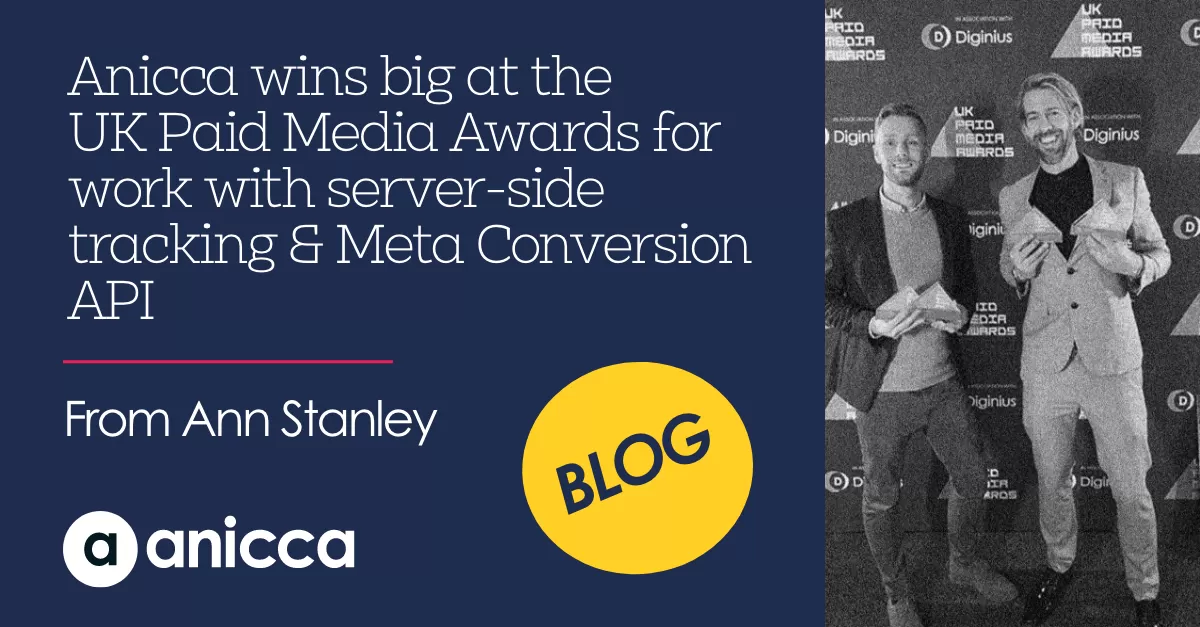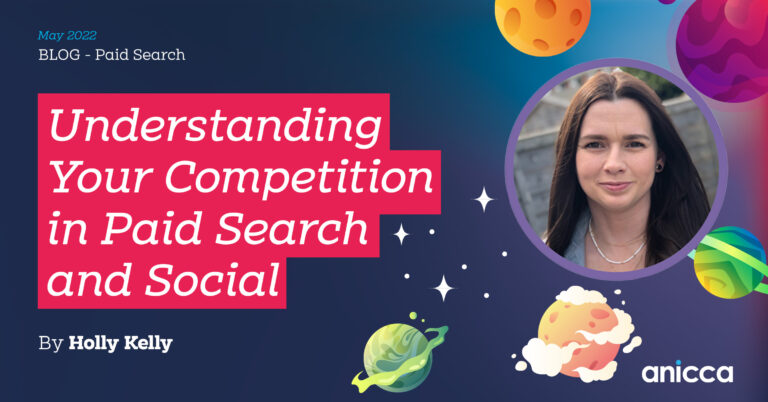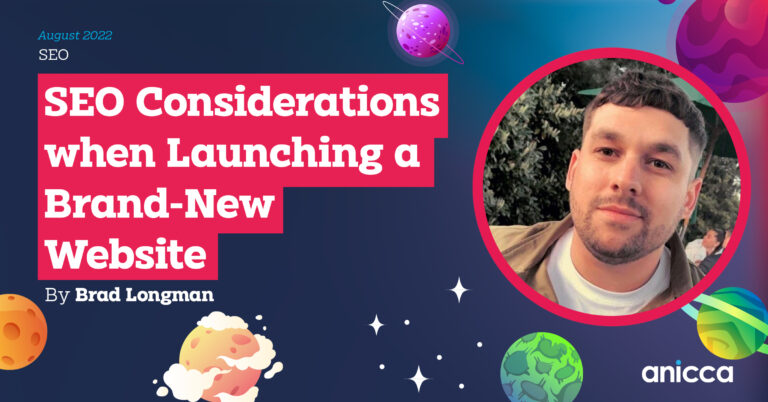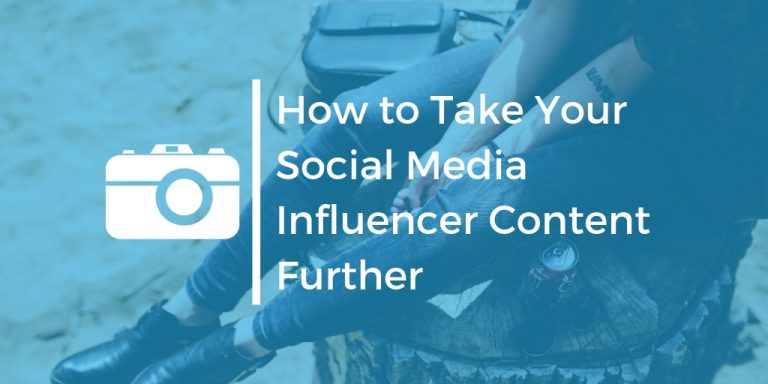Anicca wins UK Large Paid Media Agency 2023, plus 3 awards for work with server-side tracking & Meta Conversion API
We are very proud to announce that we won four awards at last month’s UK Paid Media awards, including the UK Large Paid Media Agency, and 3 other categories (Best Use of Retail, Shopping and Attribution), for the work with our client books2door.com.
This award entry demonstrated how Emil Ougendal Bolstad and Ed Truman (Strategists in the Anicca team) significantly improved the performance of Meta Conversion ads, by using Elvar’s server-side tracking and the Meta Conversion API.

1-minute summary of this award-winning case study for Books2Door
- Using Conversion API and server-side tracking to overcome the Apple iOS14 privacy update and its impact on advertisers, such as Meta
- iOS 14 and other privacy changes have significantly impacted the performance of conversion-based bidding in Meta, as most conversion data became invisible when users opted out of having their personal data tracked
- Many ad platforms are now providing a Conversion API (CAPI), which can be used as a back-door to inject conversion data into the ads platform.
- This blog explains how CAPI (and server-side tracking) can be used on your website and the benefits of implementing these technologies to improve your conversion tracking
- Describing the strategy behind the Books2Door case study, which led to 3 awards at the UK Paid Media Awards
- In this case study, we present the strategy and techniques used for our client Books2Door, which led to 3 wins at the UK Paid Media Awards in March 2023, plus the UK Large Paid Agency award
- We used Elevar, a Shopify Plugin, to regain conversion data. This allowed us to restart conversion campaigns and gain a significant increase in performance vs the year before
- This was combined with some sophisticated campaign design and the use of Lookalike audiences, based on website converters
- We also carried out an analysis of the differences between the data recorded in the Meta Ad Manager vs Google Analytics (GA3 /Universal and GA4).
- What was achieved – publically available results
- Using data from Similarweb; we were able to show the growth in traffic across various channels, during a time when demand was reduced (as shown in Google Trends, where there was a 30% reduction in search volume):
- Within 3 months (Sep to Nov 2022), we achieved over 40% YOY growth in traffic (from all sources) and 200% growth from social channels.
- There was significant growth in other channels, such as Direct traffic and organic search (a result of incorrect attribution and a high level of assisted conversions from Facebook).
- Although we are unable to publish revenue data (due to confidentiality); there was also a significant increase in revenue as compared to the previous year.
- We concluded that a different KPI or a blended ROAS (which includes Direct traffic) may be required to assess campaign performance, especially when using GA4
- In December 2022, the company achieved the market leader position, among their target competitors, with 40% market share vs 35% in December 2021.
- Using data from Similarweb; we were able to show the growth in traffic across various channels, during a time when demand was reduced (as shown in Google Trends, where there was a 30% reduction in search volume):
1 Introduction and Background
1:1 Purpose of this blog – explaining the benefits of moving to server-side tracking and use of the Meta Conversion API
As privacy concerns increase and cookies are retired, most ad platforms are moving away from browser-based conversion tracking. This blog explains why you need to move to server-side tracking and how to use the Meta Conversion API (CAPI) to reclaim your conversion data and relaunch high-performing ads on Facebook and Instagram.
So, the information in this blog is relevant for all advertisers and especially anyone using paid social ad platforms.
Due to confidentiality, we are only able to publish publically-available data about the client’s results. So, I have focussed this article on explaining the techniques behind the award entry.
1:2 The problems caused by the Apple iOS 14.5 update
The Apple iOS 14.5 update was released on April 26, 2021. It introduced a new feature called App Tracking Transparency (ATT), which is an enhanced privacy feature that requires users’ permission before tracking their activities across other apps and websites. This was a continuation of Apple’s push to be recognised as the platform of privacy, following the privacy updates they had made with Intelligent Tracking Prevention 2.0 (ITP) within Safari, which restricts use of cookies.
After Apple introduced ATT, all Apple and iPhone users had to give their permission when using apps on their Apple devices. Of course, most users said no, thinking that this would improve privacy and reduce the volume of ads they would see on apps like Facebook and Instagram. This was because many users had wrongly assumed that they wouldn’t be served ads. Instead, they were shown ads that were less relevant, as they were no longer personalised to their interests and behaviours (i.e. their browsing history).
ATT had several big effects on advertisers:
In addition to this annoyance for users, the impact on Meta advertisers was significant:
- Impact on targeting and personalisation
- Impacts on attribution
- Impacts on campaign optimisation.
The collection of conversion data by the ad platforms relies on the browser-based cookie data from the advertisers’ websites. So, after ATT was implemented, the conversion data from most Apple users disappeared, literally overnight.
- In the UK, over half of mobile phone users have iPhones and a large percentage of them declined the use of cookies (see background data at the end of this blog).
- The number of website conversions displayed in Ads Manager was significantly reduced, making manual account management and optimisation more difficult for conversion campaigns i.e. there was less data to make decisions on the best targeting or creative.
- The algorithm used in conversion campaigns is designed to find more users that are similar to the users that have already converted. Once the algorithm had less data to work with, then the performance of ‘conversion-bidding’ started to drop off.
- This also meant that there were fewer ‘website converters’. These anonymous individuals can be used for creating remarketing audiences, and can also be used to create a Lookalike audience, for finding new customers in Prospecting campaigns.
As a result of all these impacts, many advertisers lost confidence in the effectiveness of their conversion campaigns and reduced their budgets, creating a vicious downward spiral.
Interestingly, Google was much less affected than Meta, which is not app-based.
How did advertisers respond?
Although many Meta advertisers continued to invest in Awareness and Traffic-based campaigns (which used data from within the platform), many withdrew their budgets from conversion-based ads, which resulted in less revenue for the advertisers, as well as for Meta.
Options for advertisers to mitigate the impact of ATT
This left advertisers with several choices:
- Do nothing and lose a large amount of traffic and sales
- Replace Meta traffic and sales by using alternative channels
- Create dedicated funnels and landing pages for Facebook-only traffic
- Find alternative tracking methodologies to continue to report conversions, such as:
- working with analytics data outside of Facebook to report and optimise
- or experimenting with uplift studies
Our approach was to find alternative tracking methodologies:
- Using server-side tracking to collect the conversion data
- Combined with the newly developed Meta Conversion API, which allows advertisers to import conversion data, directly into the ad platform.
1:3 Introduction to server-side tracking
Server-side tracking is a method of collecting and processing data about users’ interactions, by sending tracking data from the server of a website or application, rather than relying solely on client-side tracking via JavaScript.
- With server-side tracking, the tracking code is executed on the server before the page is served to the user, meaning the data is collected and processed before it reaches the user’s browser.
- This is shown in the diagram below, where Google Tag Manager has been installed on the server-side, and is used to send tracking data to Analytics and the ad platforms
Diagram showing the use of Google Tag Manager on the client-side and server-side
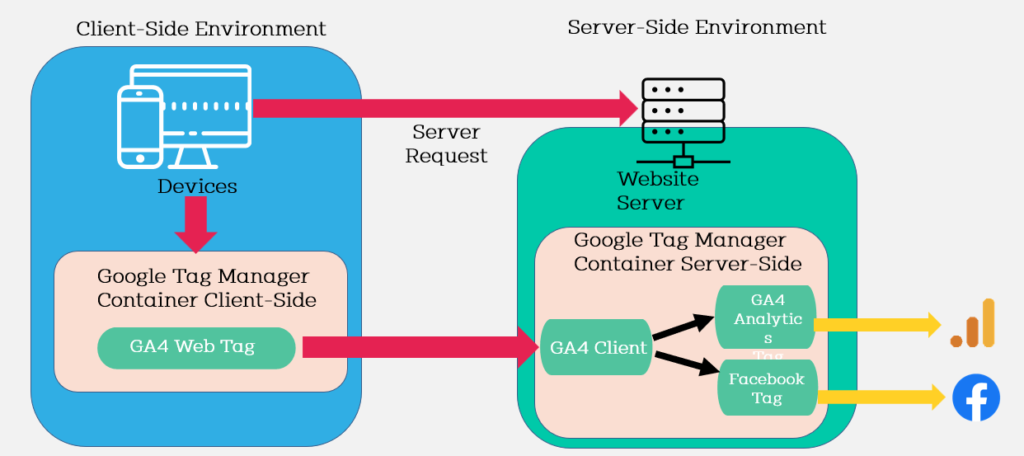
Server-side tracking can provide a number of advantages over client-side tracking, including:
- Greater privacy and security,
- More accurate data collection,
- The ability to integrate with other systems and applications,
- Improved page load times due to less on-page JavaScript.
1:4 What is a Conversion API (CAPI)?
A Conversion API (CAPI) is designed to create a direct connection between an advertiser’s marketing data and the back-office systems of the ad platform. Several ad platforms are already using Conversion APIs, including Meta (Facebook and Instagram), Google Ads, TikTok and Pinterest.
The conversions that can be imported into a CAPI, include:
- Online conversions – such as website and app events
- Offline conversions – from an advertiser’s server, website platform, mobile app, or CRM.
Once this data is imported into the ads manager, it can then be used to:
- Measure conversions (and other outcomes), so you can understand campaign performance
- Optimise ad targeting and ad creative in order to increase account performance, e.g by decreasing the cost per Conversion.
- Create audiences, e.g. of converters, for use in remarketing or for creating Lookalike audiences for prospecting.
The main advantage of using an advertising CAPI is that it bypasses the need for Pixels and Cookies, which can be blocked by Apple’s ATT or other ad blockers. Instead, it uses your own “first-party” data, from your server, to feed conversion data back to the ad platform; as shown in the diagram below.
Diagram to show the use of Conversion API (CAPI) as compared to Browser-based conversion tracking (Pixel)
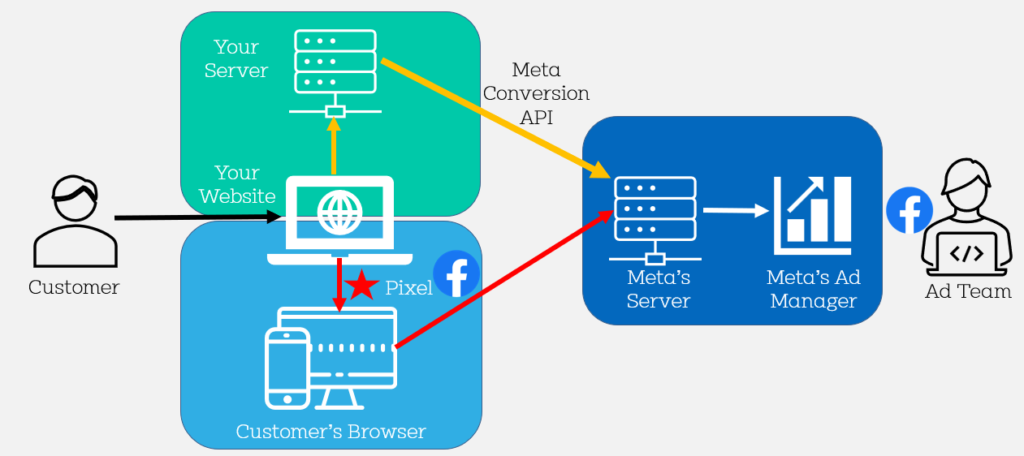
Note, there is still a need to use the Facebook web pixel in conjunction with the Conversions API in order to get the full array of data and full user journey.
1:5 Setting up server-side tracking and CAPI
There are some off-the-shelf solutions available, for example, in our project, we selected Elevar, which works with Shopify sites. For some useful information on server-side tracking and its solutions, you may want to read this article from Elevar.
If you are not using Shopify, then Elevar will not be suitable, so you will need to look at alternative solutions. Meta provides some useful resources on the various options for implementing conversion tracking. This includes:
- Native ecommerce connectors (Shopify)
- 3rd Party partner (Stape, Elevar, Zapier)
- Conversion API Gateway (manual)
The Meta article mentions some of the native connectors that can be used to link specific website CMSs with the Meta CAPI. However, for more complex sites, there may be additional advantages to setting up your own server-side tracking and CAPI. This involves:
- Creating a cloud server, which is typically on a subdomain of your website, so the data is treated as ‘first-party’
- Using server-side Google Tag Manager (GTM) to send tracking and conversion data to Analytics and the ad platforms via their APIs.
We can assist you with this service, so please contact us if you need advice on the best approach for your site (see contact details below).
1:6 Discrepancies between Meta Ads Manager and Google Analytics data
The loss of faith in Meta ads was also aggravated by a lack of advertisers’ trust in the data in the Meta Ads Manager, as compared to what was recorded in Google Analytics. For example, in our research, we have found that as little as 25% of the revenue recorded in Meta Ads Manager (1-day click-only attribution) is attributed to Facebook or Instagram when viewed in GA3 (last click attribution).
This notable discrepancy between the data in Meta Ads Manager and Google Analytics is due to differences in the tracking technology and the attribution windows/methodology used in the different platforms; as well as the additional issue of misclassification of traffic into the ‘Direct’ channel within Google Analytics.
Since we published this case study, there has been further research by Rand Fiskin (SparkToro) and Really Good Data, showing the amount of social traffic that is wrongly attributed to Direct Traffic within Google Analytics. The graph below shows less than 25% of Facebook traffic was accurately attributed:
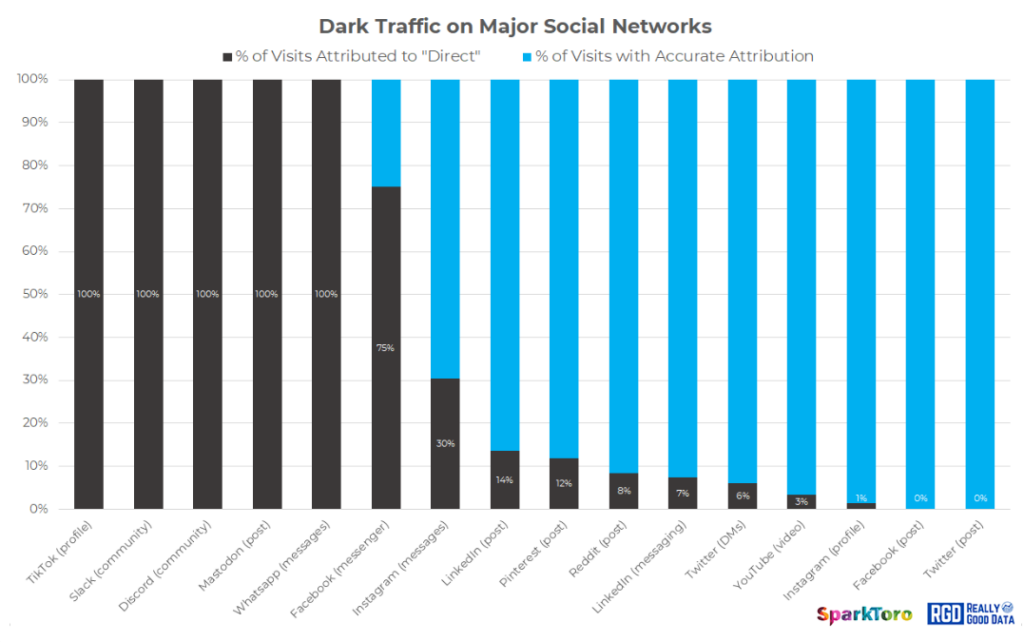
2: The case study of the Books2Door.com project
2:1 Using Elevar server-side tracking and the Meta Conversion API
In September 2022, we started our project for books2door.com, to profitably grow e-commerce revenue from Meta ads. Below are the steps used in this project:
-
- Identify and implement a solution for server-side tracking and Meta CAPI
- Create campaign structures that can be used to scale the account
- Use of personalised ads and creatives, to help brand recognition
- Creation of audiences for different stages of the funnel, e.g. custom audiences based on website converters (for remarketing) and Lookalike audiences (for prospecting)
- Comparison of data in Meta, GA3 and GA4 and overcoming issues with GA4 reporting in Google Lookers Studio (previously Data Studio)
- Use of external measures of improved performance, such as market share data from Similarweb.
Overview of Anicca’s strategy & the interaction between data, platforms & audiences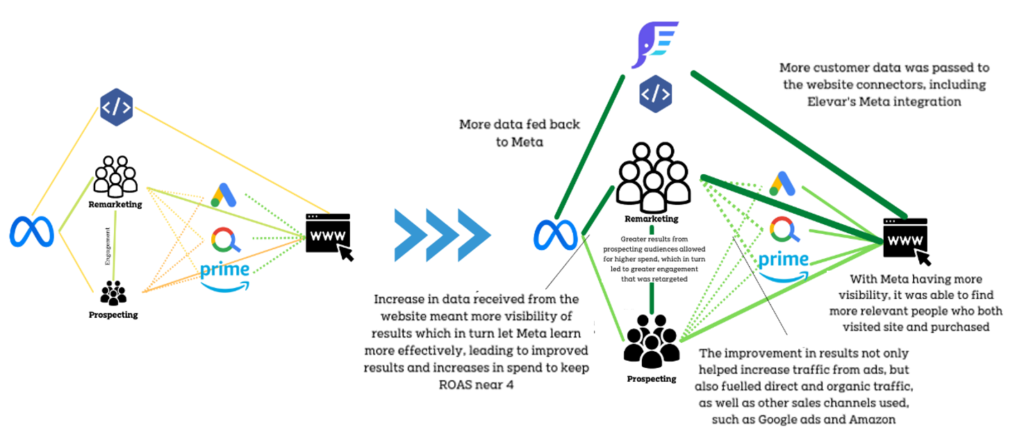
Details on how we used Elevar and the Meta Conversion API Gateway
We researched several server-side solutions to inject the conversion data into the Meta Conversion API or CAPI; ultimately testing and implementing the paid subscription service from Elevar, which is designed for use with Shopify websites*.
Elevar is a hosted solution with several packages,
- less than 1000 orders per month for $150 per month
- 1-10k orders per month for $350 per month
- Up to 50k orders per month for $750 per month.
The Elevar solution provides server-side tracking and injects the conversion data into Meta CAPI, which makes the conversions visible again. This made the conversion bidding engine more effective, increasing our revenue and ROAS. It also allowed us to create prospecting campaigns, using Lookalike audiences (based on website conversion data).
Other campaign improvements
We also needed to build sophisticated and scalable campaign structures, using a mix of prospecting and remarketing campaigns.
In addition, we implemented various paid social management best practices; such as personalised ads to increase brand recognition and recall. This helped to encourage assisted conversion via other channels, such as organic searches for the brand, direct traffic and sales on Amazon.
2:2 Results – Growth in traffic, sales and market share
Note: The client has asked us not to share any confidential information, so we are only able to present the relative increases in performance, which can be viewed publicly on platforms, such as Similarweb.
Our project resulted in the following outcomes:
- Elevar enabled the use of server-side tracking and Meta CAPI, which provided more data for improved conversion optimisation
- With sophisticated campaign design and the use of larger prospecting audiences, we were able to reach larger, better-targeted audiences, at different stages of the buying funnel
- We used personalised ad creative, which differentiated the Books2Door brand from its competitors. This resulted in additional indirect traffic and sales; such as organic searches for the brand, direct traffic to the website and increased sales on Amazon.
With more budget from the client and optimised conversion bidding; we saw a positive spiral, which resulted in more conversions, revenue and improved ROAS.
Results from Similarweb
Within 3 months (Nov 2022), Meta’s helped to deliver the following results (which can be viewed in the Similarweb charts below):
- Over 40% YOY growth in traffic, from all sources and 20% growth from social channels. There was also growth in other channels such as direct traffic, due to misclassification of social traffic and assisted conversions.
- This was despite a smaller market, as shown by a ~30% lower YOY drop in search demand (using Google’s Trend data for the most popular keyphrases).
- In December 2022, the company also achieved the market leader position, among their target competitors, with 40% market share vs 35% in December 2021.
Similarweb data showing the increase in traffic by channel
Similarweb data showing the change in traffic and market share for the top 5 sites 
2:3 Understanding measurement and attribution differences between Meta and Google Analytics
The second aspect of the project was to make direct comparisons between the conversion/revenue data in Shopify, the Meta Ads Manager and Google Analytics (GA3 and GA4); in order to try to understand the discrepancies between the data, the amount of direct vs assisted conversions and the impact of different attribution models.
This aspect of the project was not designed to resolve the issues between the different platforms, but to help with decision-making, particularly with the imminent retirement of GA3 in July 2023.
Meta vs GA data
We found various discrepancies between Meta Ads Manager and Google Analytics (GA); with the Meta ad revenue reported in GA3 being around 25% of the amount recorded in Meta (and a corresponding drop of ROAS when viewed in GA3 as compared to Meta Ad Manager). We know that this is a mix of wrongly attributed traffic in GA and also the impact of assisted conversions (see the supporting evidence above, from SparkToro and Really Good Data).
In addition, there were big discrepancies between GA4 and GA3 data:
- There was a significant difference between the two GA versions for Meta revenue
- There were huge fluctuations and on average GA4 reported 66% of GA3
- On some days no revenue was recorded at all.
- This seemed to be a specific issue with data from Meta, because, on average, GA4 reported 4% more revenue than GA3 across all channels, although there were a few days when it dropped to 80%.
- When we move to a GA4-only world, this is likely to cause some confidence issues, as the apparent conversions and revenue measured in GA4 will be lower than the current data measured in GA3
Differences between tracking all and Meta revenue in GA4 vs GA3 (%)
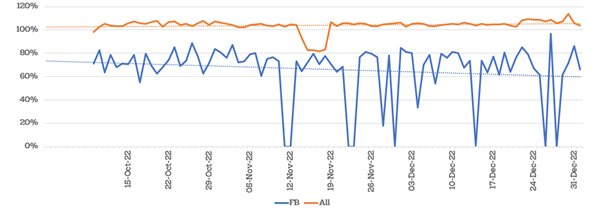
How to review and report the performance of your social results in GA
Once you have implemented CAPI for Meta (or any of the other paid channels that offer it), you will start to collect more conversion and revenue data in the platform’s Ads Manager account and also in GA.
One option is to review your results in GA using a blended ROAS:
- If you are only running Meta ads:
- Use a blended ROAS calculated from all the revenue i.e. from all the traffic sources to the site
- Combine the revenue data for Meta (source/medium) and Direct channel and use this to calculate the blended ROAS for all your Meta ads
- If you are running several paid channels:
- If you are running ads in more than one paid social platform, then you may want to combine all your social sources and the direct channels to calculate your blended ROAS
- If you are running several different paid campaigns across social, search and display then you could combine all your paid and direct channels to calculate your blended ROAS
If you (or your managers or client) are still not convinced of the validity of combining direct revenue with your social channels, then you should increase the ROAS targets within Meta. This will go some way to compensate for the big discrepancies between the results shown in Meta Ads Manager and GA4.
3: Conclusions
Anicca ran a successful campaign for Books2door.com using the Elevar plugin and server-side tracking to overcome the iOS14.5 tracking issues. This campaign shows how Anicca used a combination of off-the-shelf software, innovative campaign design and sophisticated audience targeting, allowing Books2Door to achieve impressive 45% YOY growth and become the market leader.
4: More resources and contact information
If you want to learn more about measurement and attribution in paid social, then look out for Emil’s recent webinar and #aniccast podcast on our website https://anicca.co.uk/resources-webinars/.
Alternatively contact Ann Stanley at [email protected], if you want us to help you regain your Meta conversion data and benefit from using Meta conversion ads.
5: Appendix – More information on the impact of iOS14 privacy changes on Meta ads
- The proportion of iPhones in the UK
- In January 2023, the total market share of Apple’s iOS mobile operating system in the United Kingdom (UK) reached 52.42 per cent, down from 53.63 per cent the previous year (Source = statista.com)
- How the iOS14 update impacted users of Meta and other apps
- The iOS 14 update from Apple introduced several new privacy features that impacted how users interacted with Meta and other apps.
- Meta and other companies initially opposed this change, arguing that it would hurt their ability to provide personalised ads and impact their revenue.
- However, Apple maintained that the update was necessary to give users more control over their privacy and data.
- Since the release of iOS 14, Meta and other apps have had to adjust their advertising strategies to comply with the new privacy rules.
- Impact of Identifier for Advertisers (IDFA)
- IDFA stands for “Identifier for Advertisers” and is a unique identifier assigned to a user’s Apple device, such as an iPhone or iPad.
- The primary purpose of IDFA is to enable advertisers and app developers to deliver targeted ads and track the effectiveness of their advertising campaigns, all while maintaining user privacy. With the IDFA, advertisers can measure user engagement, conversion rates, and other metrics that help them optimize their marketing strategies.
- However, in recent years, there have been growing concerns about user privacy, leading to the introduction of new regulations and updates, such as Apple’s iOS 14 update, which has significantly impacted the way IDFAs are used and shared.
- The Apple iOS 14 update brought significant changes to IDFA sharing, aiming to address privacy concerns. Previously, widespread sharing of these device identifiers was common, sometimes involving up to eight different apps or companies. While the introduction of some restrictions was warranted, the blanket approach taken by the iOS 14 update has created challenges for the digital advertising industry.

